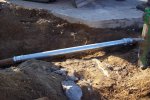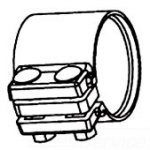- Location
- Bremerton, Washington
- Occupation
- Master Electrician
Contractor was saw cutting 8" thick concrete road, there was 3" RMC just below the bottom of the concrete. cut thru 1/2 of the RMC and that feed two traffic signals across the road. Pull out all the old rubber insulated wires, cut the conduit, repair, repull new - worked from 2 pm to 10 pm to get the signal back. Pulled about 1,000 feet of muilticonductor cable.
We use two rigid compression couplings - take the mallable one and grind out the nubs in the center so it can slide over the undamaged section and then slide back onto the new conduit. You can't do this with steel compression couplings as there center nub is a ring that goes all the way around
Does any one make a hinged split coupling - similar to a plumbing repair band?
And yes the conduit was located. Why was it so shallow? There was a foundation it went over if you look at the picuture you can see the angle of the old section on the left.
We use two rigid compression couplings - take the mallable one and grind out the nubs in the center so it can slide over the undamaged section and then slide back onto the new conduit. You can't do this with steel compression couplings as there center nub is a ring that goes all the way around
Does any one make a hinged split coupling - similar to a plumbing repair band?
And yes the conduit was located. Why was it so shallow? There was a foundation it went over if you look at the picuture you can see the angle of the old section on the left.




